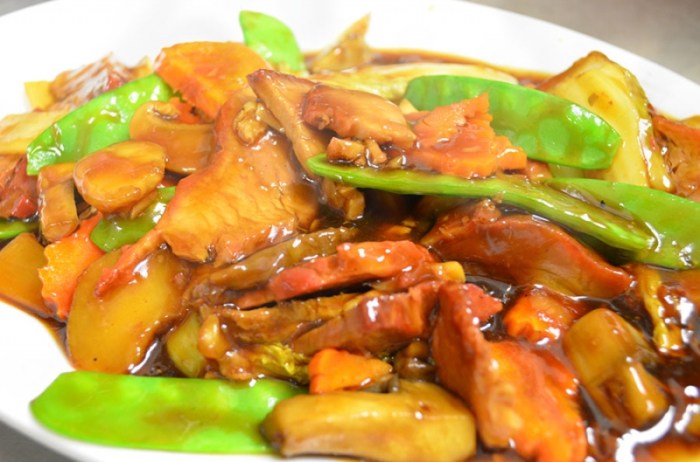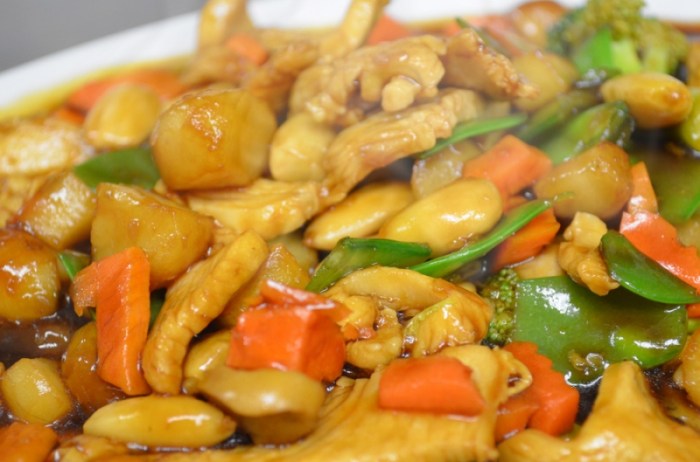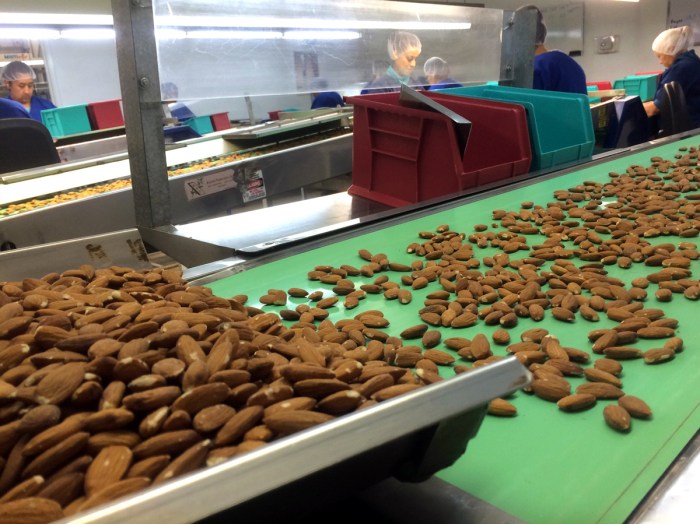Culinary term garnishing with almonds, an art form in itself, elevates dishes to gastronomic masterpieces. This versatile ingredient, with its rich history and culinary prowess, transforms culinary creations into visually stunning and tastefully tantalizing experiences.
From its humble beginnings as a garnish to its current status as a culinary centerpiece, almonds have evolved into a versatile and indispensable ingredient in the world of gastronomy. Their nutritional value and culinary applications make them an essential component of any chef’s repertoire.
Introduction

In culinary terminology, garnishing refers to the practice of adding edible or decorative elements to a finished dish or drink to enhance its visual appeal and taste.
Garnishing plays a significant role in culinary presentations as it can:
- Complement and enhance the flavors of the dish.
- Provide visual contrast and balance to the plate.
- Create a sense of occasion or festivity.
- Help to identify the ingredients or flavors in a dish.
Almonds as a Culinary Garnish

History of Almonds in Culinary Garnishing
Almonds have a rich history in culinary garnishing, dating back to ancient times. In medieval Europe, almonds were often used to decorate cakes, pastries, and other desserts. They were also used as a garnish for savory dishes, such as roasted meats and poultry.
In the 16th century, almonds were introduced to the Americas by Spanish explorers. They quickly became a popular garnish for both sweet and savory dishes in the New World. Today, almonds are used as a garnish in a wide variety of cuisines around the world.
Nutritional Value and Culinary Applications of Almonds
Almonds are a good source of protein, fiber, and healthy fats. They are also a good source of vitamins and minerals, including vitamin E, magnesium, and calcium.
In addition to their nutritional value, almonds have a number of culinary applications. They can be used as a garnish for both sweet and savory dishes. They can also be used in baking, cooking, and salads.
Techniques for Garnishing with Almonds

Incorporating almonds into garnishes adds a sophisticated touch to culinary creations. Various techniques can be employed to achieve different visual effects and textures.
Slicing and Shaping
Thinly slicing almonds creates elegant garnishes. Use a sharp knife to cut the almonds into even slices, then arrange them in decorative patterns on top of dishes.
Slivering almonds involves cutting them into long, thin strips. This technique adds a delicate touch to garnishes and can be used to create intricate designs.
Chopping almonds into small pieces provides a versatile garnish that can be sprinkled over dishes or used as a component in compound garnishes.
Toasting and Roasting
Toasting almonds enhances their flavor and adds a golden-brown color. Spread almonds on a baking sheet and toast them in a preheated oven until fragrant, stirring occasionally.
Roasting almonds at a higher temperature caramelizes their sugars, creating a rich, nutty flavor. Roast almonds in a skillet over medium heat until golden brown, stirring constantly.
Other Techniques
Blanching almonds removes their skins, revealing a pale, creamy interior. To blanch almonds, bring water to a boil, add the almonds, and cook for 1-2 minutes. Drain the almonds and immediately transfer them to cold water to stop the cooking process.
Frying almonds creates a crispy, crunchy garnish. Heat oil in a skillet and fry the almonds until golden brown. Drain the almonds on paper towels to remove excess oil.
Types of Dishes Enhanced by Almond Garnishes

Almond garnishes complement various culinary creations, elevating their visual appeal and enhancing their flavor profiles. These garnishes are particularly suitable for dishes with specific flavor combinations and textures.
Savory Dishes
In savory dishes, almonds provide a nutty crunch that complements grilled meats, poultry, and fish. Their subtle sweetness balances the richness of meats, while their delicate texture adds a delightful contrast to tender proteins. Almond garnishes are often used in Mediterranean, Middle Eastern, and Asian cuisines, where they add depth to dishes such as lamb tagine, grilled salmon, and stir-fried vegetables.
Sweet Dishes
In sweet dishes, almonds add a touch of elegance and sophistication. Their nutty flavor pairs well with chocolate, caramel, and fruit, creating harmonious flavor combinations. Almond garnishes are commonly used in desserts such as chocolate mousse, fruit tarts, and crème brûlée, where they provide a textural contrast and a touch of sweetness.
Salads and Appetizers
Almond garnishes enhance the freshness and flavor of salads and appetizers. Their crunch adds interest to leafy greens, while their nutty flavor complements tangy dressings and savory ingredients. Almond garnishes are often used in salads with fruit, cheese, or grilled vegetables, as well as in dips and spreads served with crackers or pita bread.
Creative Applications of Almond Garnishes
Almonds offer a versatile medium for culinary garnishes, inspiring innovative and artistic creations. Chefs can transform almonds into intricate edible decorations, elevating the visual appeal of dishes. Additionally, molecular gastronomy techniques provide opportunities to incorporate almonds into garnishes in novel ways.
Edible Almond Decorations
Almond slices or slivers can be arranged in geometric patterns or used to create edible flowers, adding a touch of elegance to desserts and salads. Finely chopped almonds can be used as a textural element in breading or crusts, providing a nutty crunch.
Almond paste can be molded into various shapes, such as fruits or animals, creating whimsical and edible centerpieces.
Molecular Gastronomy Techniques
Molecular gastronomy techniques allow chefs to explore the unique properties of almonds in garnishes. For instance, almond milk can be transformed into a foam or gel, adding a light and airy texture to dishes. Almond oil can be emulsified to create a delicate sauce or dressing, enhancing the flavor of grilled meats or seafood.
Examples of Creative Almond Garnishes, Culinary term garnishing with almonds
- Almond tuiles: Thin, crispy almond cookies shaped into intricate designs, adding a touch of elegance to desserts.
- Almond foam: A light and airy foam made from almond milk, adding a delicate texture to soups and sauces.
- Almond oil emulsion: A smooth and flavorful emulsion made from almond oil, enhancing the taste of grilled dishes.
- Almond spheres: Edible spheres made from almond paste, filled with a sweet or savory filling, creating a unique and visually appealing garnish.
Benefits of Using Almonds as a Garnish

Incorporating almonds into culinary garnishes offers a multitude of culinary benefits, contributing to the overall flavor, texture, and presentation of dishes.
Flavor Enhancement
Almonds possess a distinctive nutty flavor that can complement and enhance various dishes. Their rich, earthy taste adds depth and complexity, balancing out sweet, savory, and spicy elements.
Texture Variation
Almonds provide a delightful textural contrast when used as a garnish. Their crunchy exterior and soft interior create a satisfying mouthfeel, adding interest and dimension to dishes.
Visual Appeal
Almonds’ natural golden-brown hue and elegant shape make them visually appealing. They can add a touch of elegance and sophistication to any culinary creation, enhancing the overall presentation.
Nutritional Advantages
Almonds are a nutrient-rich food, making them a healthy addition to garnishes. They are a good source of protein, fiber, and healthy fats, providing essential nutrients without compromising the taste or visual appeal of dishes.
Case Studies of Successful Almond Garnish Applications
Almond garnishes have gained popularity in culinary applications, enhancing the visual appeal and flavor profiles of various dishes. Here are notable examples of restaurants and chefs who have successfully incorporated almond garnishes into their creations:
Alinea, Chicago
- Chef Grant Achatz has showcased almond garnishes in his signature dishes, such as the “Black Truffle Explosion” and “The Egg.” In “The Egg,” a delicate egg yolk is adorned with toasted almonds, adding a textural contrast and nutty flavor.
- The almond garnish complements the dish’s luxurious ingredients, elevating the overall dining experience.
Eleven Madison Park, New York City
- Chef Daniel Humm has used almond garnishes to accentuate the flavors of seafood dishes. In his “Hamachi Crudo,” thinly sliced yellowtail is paired with toasted almonds, creating a harmonious balance of delicate flavors.
- The almonds add a subtle crunch and nutty aroma, enhancing the freshness of the fish.
The French Laundry, Yountville, California
- Chef Thomas Keller has incorporated almond garnishes into both savory and sweet dishes. In his “Roasted Rack of Lamb,” the lamb is crusted with toasted almonds, adding a crispy texture and nutty depth to the meat.
- In his “Almond Milk Panna Cotta,” almond slices provide a delicate garnish, complementing the creamy and smooth texture of the panna cotta.
Impact on Dining Experience
Almond garnishes not only enhance the visual appeal of dishes but also contribute to the overall dining experience in several ways:
- Texture:Almonds add a satisfying crunch or delicate crispness to dishes, providing a textural contrast to soft or smooth components.
- Flavor:Almonds impart a nutty and subtly sweet flavor, complementing a wide range of ingredients and dishes.
- Aroma:Toasted almonds release a fragrant aroma that stimulates the senses and enhances the overall dining experience.
- Presentation:Almond garnishes add a touch of elegance and sophistication to dishes, making them visually appealing and inviting.
Conclusion
In summary, garnishing with almonds offers culinary professionals an array of creative possibilities to enhance the visual appeal and taste of their dishes. The versatility of almonds as a garnish stems from their distinct texture, nutty flavor, and compatibility with various cuisines.
By understanding the techniques for garnishing with almonds and exploring the types of dishes they complement, chefs can elevate their culinary creations to new heights.
As the culinary landscape continues to evolve, we can anticipate innovative trends and techniques in almond garnishing. Chefs may experiment with different textures, such as caramelized or smoked almonds, to add depth and complexity to their dishes. Additionally, the incorporation of almonds into compound garnishes, combining them with other ingredients like herbs, fruits, or sauces, can result in visually stunning and flavorful presentations.
User Queries: Culinary Term Garnishing With Almonds
What are the nutritional benefits of almonds?
Almonds are rich in fiber, protein, healthy fats, and essential vitamins and minerals, making them a nutritious addition to any diet.
How can I incorporate almonds into garnishes?
Almonds can be sliced, slivered, chopped, or ground into a powder to create a variety of garnishes that add texture, color, and flavor to dishes.
What are some creative ways to use almond garnishes?
Almond garnishes can be used to create edible decorations, such as almond flowers or trees, or to enhance the visual appeal of desserts, salads, and entrees.